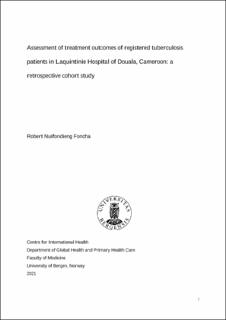| dc.description.abstract | Background Globally, tuberculosis is a major public health problem and especially in low-income settings where resources are limited for proper treatment. The disease is managed by control programs that follow patients throughout the treatment with outcomes routinely assessed and reported to promote successful TB treatment and survival of patients. However, Cameroon still records a large proportion of TB-related fatalities and studies have also shown a low treatment success rate of TB patients. Objectives We assessed treatment outcomes and factors associated with unsuccessful treatment outcomes on registered TB patients enrolled in the DOTS program in Laquintinie Hospital of Douala (LHD), Cameroon Methods A hospital-based retrospective cohort study was carried out by reviewing the TB registers of all TB patients enrolled in the DOTS programme at LHD from 2016-2019. Data was collected from all registered TB patients of all ages. Double data entry was done. For analysis we used crosstabulations and logistic regression to assess the determinants of unsuccessful treatment outcomes. Results Among the 3,321 registered cases with complete treatment outcome data, 86.9% were newly diagnosed. Males made up 53.9% of the new and 58.1% of the retreatment cases. Seroconversion was recorded in 33.8% of the new and 47.1% of the retreatment cases with 10% deaths among those HIV positive. New cases had 84.4% success. Retreatment cases had 74.5% success, 1.4% failure, 6.9% death, 6.2% lost-to-follow-up and 11.1% transferred out. For new cases, increased risk of unsuccessful treatment outcome was high in patients aged ≥55years (aOR 1.53, 95% CI: 1.07 - 2.18), having initial smear results of (+) (aOR 1.57, 95% CI: 1.10 - 2.22) and (++) (aOR 2.01, 95% CI: 1.43 - 2.83), being diagnosed and treated in the years 2017 (aOR 1.85, 95% C.I: 1.25 – 2.73) and 2019 (aOR 2.13, 95% C.I: 1.48 – 3.06) and with double risk in those HIV positive (aOR 2.26, 95% CI: 1.75 - 2.92). The risk of unsuccessful treatment was almost double if being diagnosed and treated in the years 2017(aOR 0.53, 95%CI: 1.05 - 6.10), and 2019 (aOR 2.93, 95% C.I: 1.34 – 6.43) for the retreatment cases. Conclusion and recommendation Treatment success of the retreatment cases (74.5%) was lower than the NTB program and WHO target. Proper tracing and follow-up of the “failed” and “lost-to-follow-up” retreatment cases is therefore needed to address concerns for MDR. | |
